Types of Willow Shrubs (With Pictures) – Identification Guide
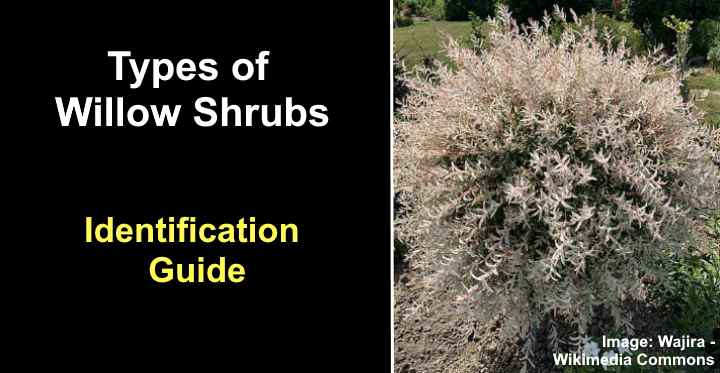
Willow shrubs are deciduous, broadleaf, multi-stemmed bushes with many uses in the landscape. Willow bushes are known for their brightly-colored stems, fuzzy flowers, and slender lance-shaped leaves. Willow shrubs are some of the first woody plants to leaf out, and it’s common to see red willow stems with grayish furry catkins covering them.
Small woody willow plants are beautiful shrubs that bring color to garden landscapes from spring through fall and throughout winter. The shrubby plants are easy to care for and help prevent soil erosion. Willow shrubs grow well in damp soil and are useful for growing as living fences, screens, or container plants.
This article is an identification guide to various types of willow shrubs. Descriptions and pictures of these low-growing, multi-stemmed plants will help you identify willow bushes for your garden landscape. Also, helpful tips will help you know how to use willow shrubs to beautify your front or backyard.
What Are Willow Shrubs?
Willow shrubs are small bushy plants with multiple slender woody stems emerging from the ground. There are over 400 species of deciduous willow plants belonging to the genus Salix and the family Salicaceae. Willow shrubs range from the small arctic and alpine species to the popular dappled willow.
Willow Shrub Facts
Many willow shrubs are native to North America and are used in landscaping and hedges. The shrubby plants thrive in poor soils that have high moisture content. As a result, you will often find deciduous and semi-deciduous willow shrubs thriving near freshwater sources in cold and temperate regions.
Willows may go by the name osier or sallow. Osier refers to species of willow shrubs with narrow, linear leaves that have serrated margins. On the other hand, sallow refers to willow shrubs with broader leaves. Most species of willow shrubs are dwarf cultivars or hybrids or belong to the arctic species.
Some willow shrub species are small woody plants called pussy willows. They get their name from the furry catkins that appear on stems in early spring. These bud-like flowers are covered in grayish fur, reminiscent of tiny pussy cats. The catkins appear on branches long before leaves appear on the shrub stems. As the season progresses, the catkins can change to yellow or purplish-red.
The flexible stems of many willow shrubs make them excellent for basketry. The long, slender stems have a waxy skin and high water content. Depending on the species, the branches can typically be reddish-green and then dry to a deep orange color.
Although most people associate willows with the graceful weeping willow tree, willow shrubs are extremely common. Many of the large shrubs are known for their red stems that become vibrant crimson in the winter. Additionally, the narrow, pointed willow leaves can be bluish-green or silvery-green, adding even more color to a landscape.
Related reading: Red twig dogwood shrubs.
Willows grow in various habitats, including wetland areas, riverbanks, stream banks, and beside ponds. Due to their tolerance to poor soils and salty air, willows also grow near coastal areas. And thanks to their tight root system, they help prevent erosion of sand dunes, slopes, and river banks.
How to Identify Willow Bushes
The best way to identify willow shrubs is by the shape of and color of their leaves. The leaves of willow bushes are typically round to oval with an elongated form. However, some willow shrubs have linear, slender leaves. Leaf color can range from yellow to shades of green and bluish tones. And most willow leaves have slightly toothed margins.
Types of Willow Shrubs (With Pictures and Identification)
Willow plants are typically large shrubs or trees. Because of their suckering nature, many willow plants naturally grow as bushy shrubs. With pruning, you can train the shrubby plants to grow as single-stemmed trees. However, many willow plants have a natural shrub-like growth.
Dappled Willow Shrub (Salix integra ‘Hakuro Nishiki’)
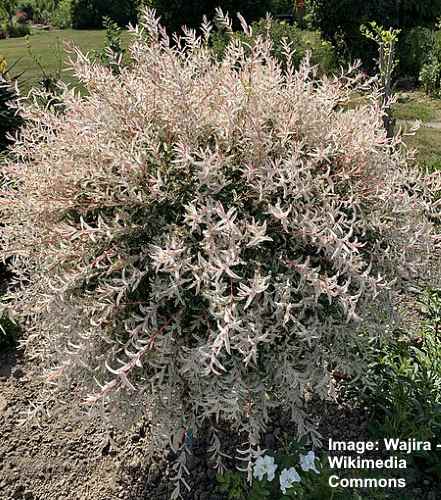
The dappled willow is a type of variegated small willow shrub
The dappled willow shrub has spectacular variegated pink, cream, and green leaves growing on slender stems. The distinctive colorful leaves turn a delightful green shade by summer. The stems become vibrant coral red during winter to brighten a bare winter landscape. The stunning willow shrub is also called the tri-color willow.
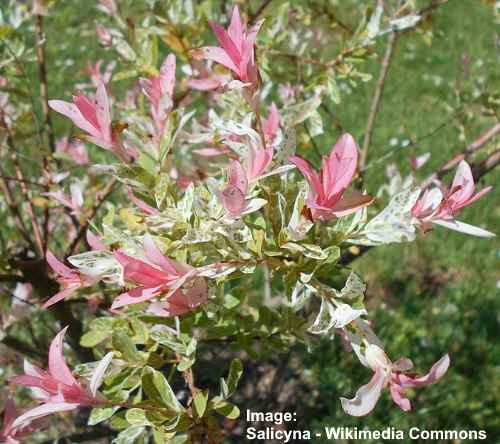
Dappled willow leaves are green, cream and pink
The dappled willow shrub grows 4 to 6 ft. (1.2 – 1.8 m) tall and wide. You can plant the shrub in full sun, where its spectacular three-colored leaves will bring color to a spring landscape. In the fall, the willow shrub’s foliage turns bright yellow and drops to reveal stunning red stems.
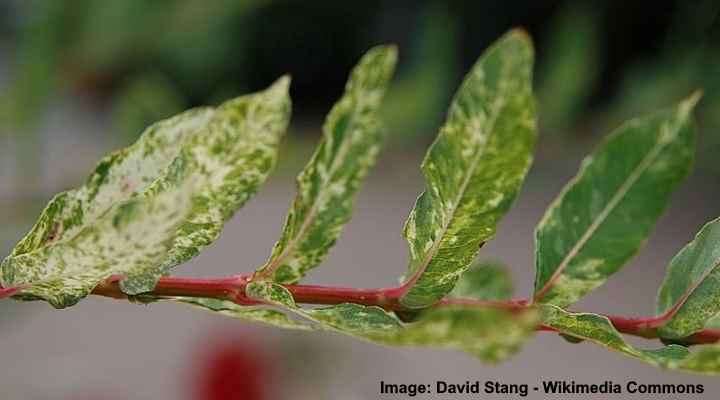
Dappled willow red stems
You can use the dappled willow shrub as an ornamental accent plant in shrub beds and borders. In addition, the colorful pink, cream, and green leaves and low growth habit make the shrub ideal as a foundation plant, privacy screen, or container plant.
The dappled willow shrub is suitable for growing in USDA zones 5 through 7. The bright red stems are most vibrant during winter in zones 4 and 5.
Willow shrub identification
The dappled willow shrub is identified by its brightly colored creamy-pink and green slender lanceolate leaves.
Bebb’s Willow Shrub (Salix bebbiana)

Bebb’s willow is a fast growing short-lived shrub
The Bebb’s willow shrub is a multi-stemmed bush with thick oval to lanceolate leaves and distinctive diamond markings on the thick woody stems. This fast-growing shrub thrives in wetlands throughout the northern half of North America. However, the woody shrub is not used for landscaping because it’s short-lived and prone to insects and diseases.
Identifying features of the Bebb’s willow bush are its pointed dull-blue-green leaves measuring 5” (13 cm) long, small dangling catkins, and colorful woody stems.
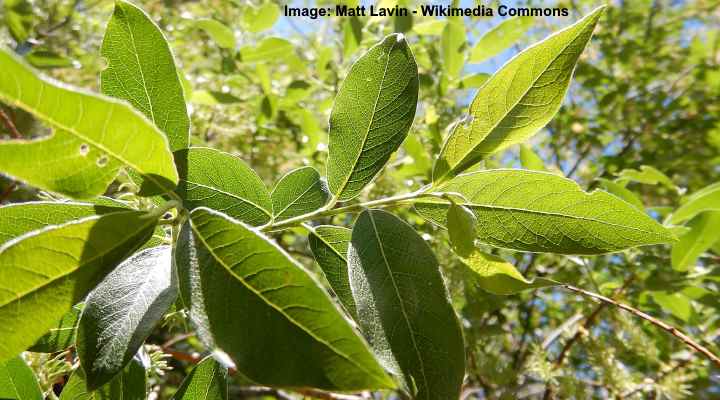
Bebb’s willow leaves
The Bebb’s willow shrub grows 10 to 30 ft. (3 – 9 m) high and thrives in USDA zones 3 through 7. However, it’s relatively rare to find the shrub growing south of zone 4. Like most willow shrub species, the large plant is drought-resistant and thrives in full sun to partial shade.
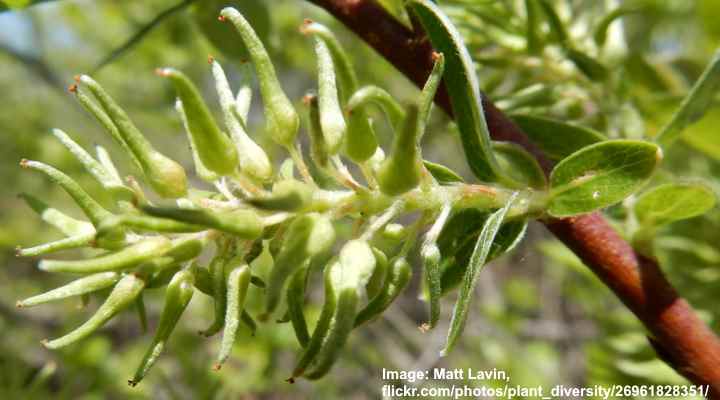
Bebb’s willow catkins have distinct look with round base and a long beak
The Bebb’s willow shrub also goes by the names diamond willow, red willow, gray willow, or long-beaked willow.
Willow shrub identification
The Beeb’s willow shrub is identified by its green lance-shaped leaves that taper at both ends, growing on thick, colorful stems.
Goat Willow Shrub (Salix caprea)
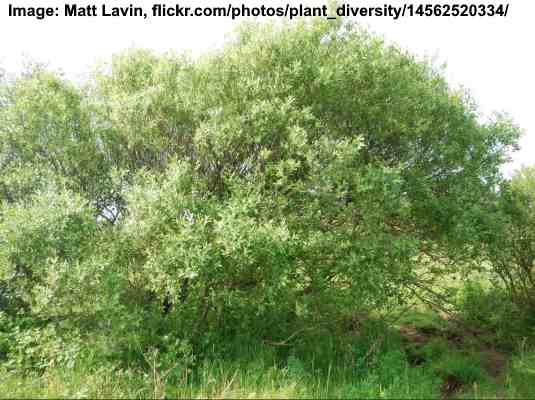
Goat willow is a large shrub or a small tree
Goat willow shrub is a type of pussy willow known for its fuzzy, soft, silky yellowish-green catkins, broadly elliptic, velvety leaves, and greenish-yellow fall color. The shrub’s landscaping feature is its large woolly catkins on brown stems. This pussy willow grows as a large shrub with a rounded habit or a small tree.
Its pointed, oblong leaves measure 1.18” to 4.7” (3 – 12 cm) long and up to 3.14” (8 cm) wide. The large cone-shaped fuzzy catkins measure 1.18” to 2.75” (3 – 7 cm) long.

Goat willow leaves
Goat willow shrubs grow 12 to 25 ft. (3.6 – 7.5 m) tall and thrive in full sun and moist, well-drained soil. The furry flowers are the first to bloom in spring and are an important early source of pollen and nectar for insects. In addition, the shrubby plant, with its densely growing foliage, can be used as a hedge or windbreak.

Goat willow catkins
The goat willow shrub is suitable for growing in USDA zones 4 through 8. Other names for the willow shrub are European pussy willow or great sallow. It is also simply called pussy willow.
Willow shrub identification
The identifying features of the goat willow shrub are its large silky silvery catkins that turn yellow or pale green, and oblong or broadly elliptic dark green leaves.
Purple Osier Willow Shrub (Salix purpurea)
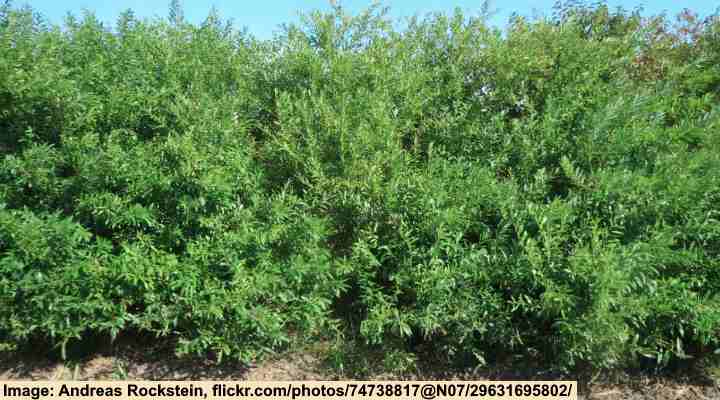
Purple osier willow shrubs can be planted to create a living fence
The purple osier willow shrub is an ornamental leafy plant with a rounded habit, finely textured blue-green leaves, and silvery catkins. The attractive feature of the purple willow shrub is its dark green leaves with a silvery underside. These make the shrub appear to shimmer in breezes.
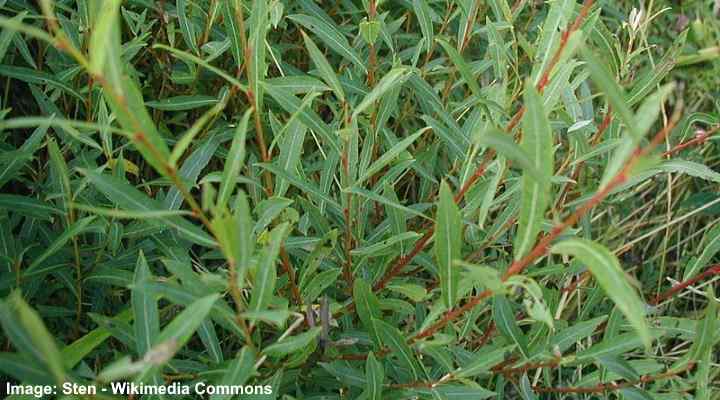
Purple osier willow leaves
The purple willow shrub grows 10 to 15 ft. (3 – 4.5 m) tall and wide. The densely growing foliage, fast growth, and suckering habit make this willow shrub perfect for hedges and screens or for preventing soil erosion near streams and ponds. Cutting the shrub back every three to five years helps to maintain its low, bushy growth.
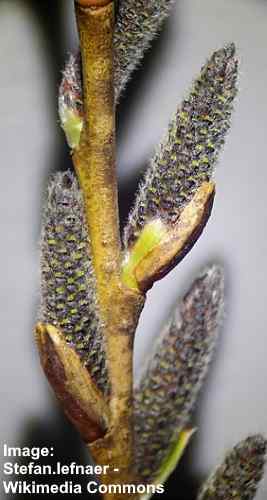
Purple osier willow catkins
The attractive shrub thrives in USDA zones 4 through 7, with full sun and well-drained medium to wet soil.
Willow shrub identification
Also called the basket willow or blue willow, the purple osier willow shrub is identified by its blue-green, narrowly oblong leaves, purple-reddish stems, and slender silvery catkins.
Dwarf Blue Leaf Arctic Willow Shrub (Salix purpurea ‘Nana’)
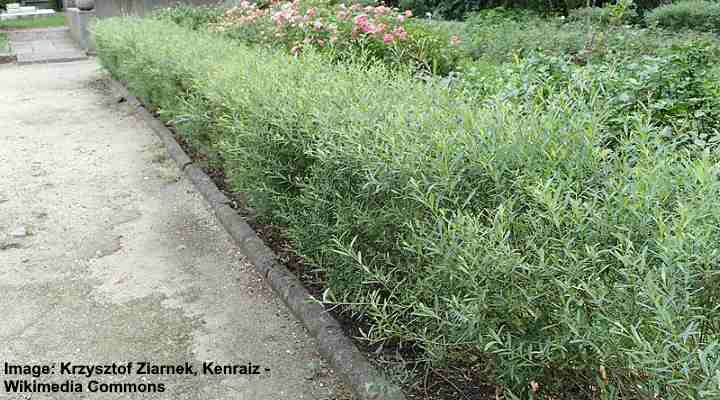
The dwarf blue leaf arctic willow is a low growing attractive shrub suitable for a low informal hedge
The dwarf blue leaf arctic willow shrub is a desirable landscaping shrub due to its silvery-blue leaves with silver undersides growing on deep purple stems. The beautiful, rounded shrub looks stunning in breezes when the foliage appears to glitter and sparkle. Also called the dwarf purple osier, it’s a compact willow shrub for landscaping.
The dwarf willow shrub, with its lush blue-green pointed leaves, grows 3 to 5 ft. (1 – 1.5 m) tall. The small shrubby plant has dark red or purple stems in fall and late winter. In addition, showy male catkins appear in early spring on bare branches.
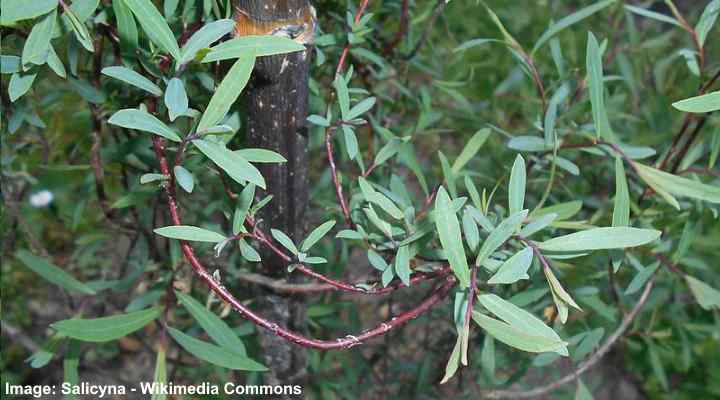
Dwarf blue leaf arctic willow leaves and stems
The dwarf purple willow shrub is suitable for growing in USDA zones 4 through 8. Like all willow species, the compact shrub thrives in low-ground areas near streams, ponds, and lake shores. Its landscaping features for residential gardens are its purple twigs and catkins, ornamental foliage, and fast growth.
Willow shrub identification
The dwarf blue leaf arctic willow shrub is easily identifiable due to its purplish stems, narrow, linear bluish-green foliage, and tiny purple catkins growing in small clusters.
Rose-Gold Pussy Willow Shrub (Salix gracilistyla)

The rose-gold pussy willow is a wide spreading low maintenance shrub
This rose-gold pussy willow shrub is a deciduous plant featuring beautiful bluish-gray leaves and large fluffy gray catkins. The 1” (2.5 cm) long gray catkins with their rose and gold shades cover the slender reddish-brown stems. The shrub’s dark green summer foliage turns bright golden yellow in the fall.
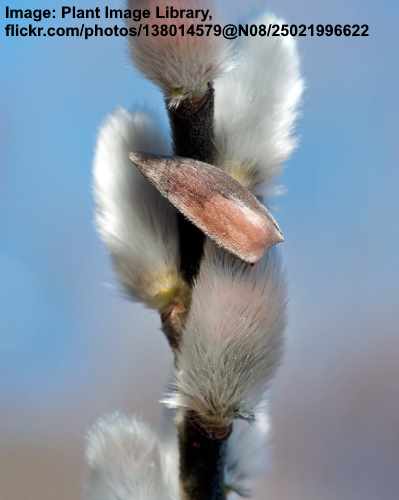
Rose-gold pussy willow catkins
The rose-gold pussy willow shrub grows up to 19 ft. (6 m) tall , but usually not more than 6 to 10 ft. (2 – 3 m) high and wide. This willow shrub is a great choice as an ornamental plant for sunny landscapes. In addition, the mounding, wide-spreading willow shrub is perfect for preventing soil erosion, creating a privacy screen, and landscaping gardens.
Like most willows, this pussy willow shrub requires minimal care and tolerates poor soils. Grow the shrub in USDA zones 5 through 8 in moderately fertile, well-drained, moist soil.
Willow shrub identification
The rose-gold pussy willow shrub is identified by its soft, blue-gray narrow leaves growing 2” – 4” (5 – 10 cm) long, yellow fall colors, and gray catkins with hints of pink and golden yellow.
Japanese Pink Pussy Willow Shrub (Salix gracilistyla ‘Mount Aso’)
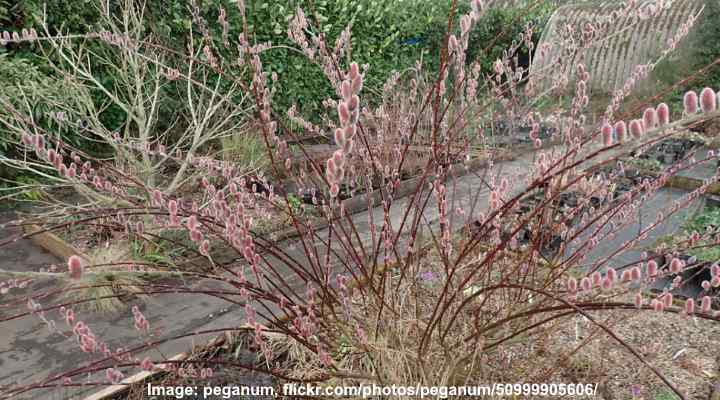
Japanese pink pussy willow is a small ornamental shrub for sunny locations
The Japanese pussy willow is a bushy shrub with stunning furry, pink-tinged rosy catkins emerging in late winter and early spring. This beautiful flowering shrub features bluish-green oval leaves with silky undersides. With its arching stems and mounding habit, this pussy willow is an ideal dwarf landscaping shrub.
The Japanese pink pussy willow cultivar grows 5 to 6 ft. (1.5 – 1.8 m) tall and wide. The compact ornamental shrub thrives in full sun and moist, well-drained soil. You can plant the willow as a focal point in winter gardens or grow it as a decorative hedge row or front-of-house foundation plant.
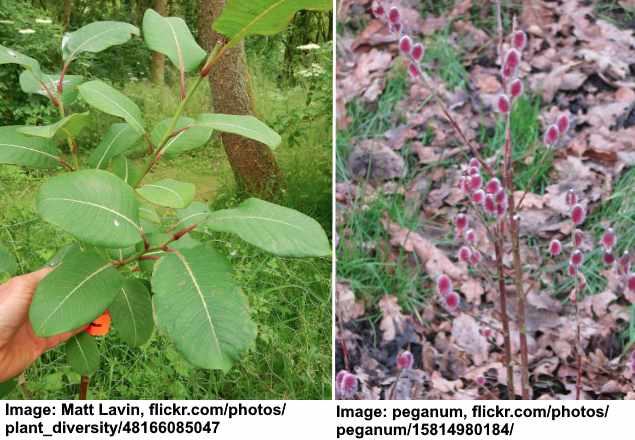
Japanese pink pussy willow leaves and catkins
To maintain the shrub’s compact growth, cut it back every three to five years. This way, you can enjoy its attractive rosy-pink fuzzy catkins that cover the reddish stems in late winter and early spring.
The Japanese pink pussy willow grows best in USDA zones 4 through 9.
Willow shrub identification
The Japanese pink pussy willow shrub can be identified by its pink catkins covered in soft silvery fuzz. The willow shrub has small elongated oval green leaves with a soft underneath, and attractive arching stems.
Black Pussy Willow Shrub (Salix gracilistyla ‘Melanostachys’)
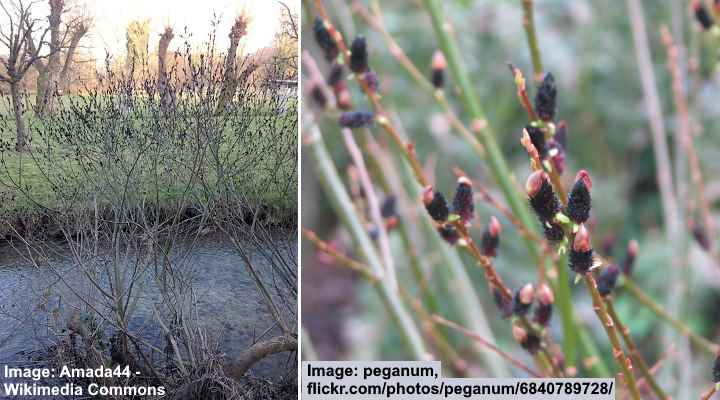
Black pussy willow shrub (left) and black catkins (right)
The black pussy willow shrub is a fast-growing bushy shrub with deep purplish-black catkins growing profusely on bare purple-reddish stems. These black catkins develop pronounced red anthers, giving them a distinctive, unique appearance. The willow shrub features grayish-green leaves that turn glossy green as the season progresses.
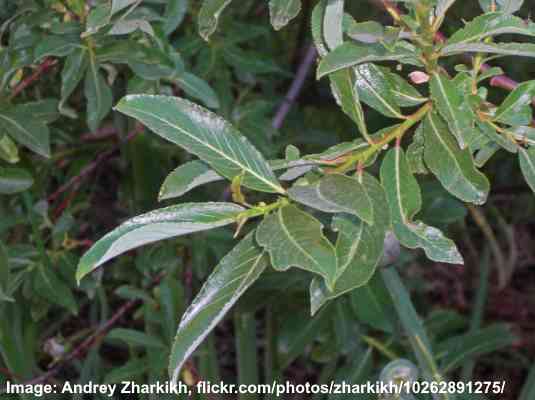
Black pussy willow leaves
The black catkin willow shrub grows 6 to 10 ft. (1.8 – 3 m) tall and wide. You can plant the large shrub as an ornamental specimen plant in informal, coastal, or residential gardens. The unusual black and purplish-pink catkins growing on red stems are ideal for creating eye-catching spring floral arrangements.
The black pussy willow shrub thrives in USDA zones 5 through 7. To ensure healthy foliage and proliferation of deep purplish-black and red catkins, grow the shrub in full sun to part shade, ensuring the soil is well-draining but consistently moist.
Willow shrub identification
The black pussy willow shrub is easily recognized by its purple-black catkins crowned with reddish-pink anthers followed by pointed, oval, glossy green leaves.
Coyote Willow Shrub (Salix exigua)
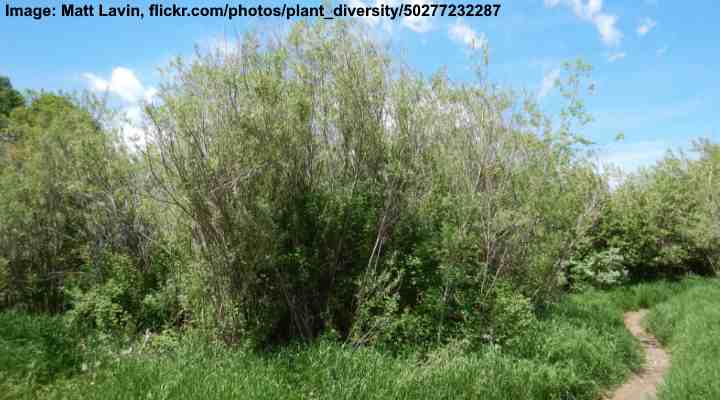
Coyote willow shrub has a suckering nature and its extensive root system helps preventing soil erosion
The coyote willow shrub is a large thicket-forming bushy plant with narrow, linear leaves, pale yellow catkins, and clusters of tiny seed pods. The leaves on the coyote willow help to tell it apart from other willow shrubs. They are slender and long and emerge silvery before turning gray-green. The leaves and catkins appear around the same time.
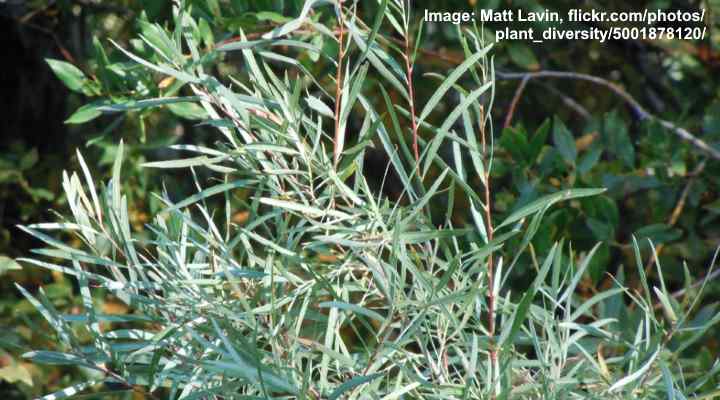
Coyote willow leaves
Also called the narrowleaf willow shrub, the coyote willow shrub grows 15 to 20 ft. (4.5 – 6 m) tall. This willow shrub has characteristic suckering nature and extensive root system. It forms a large mound of silky, silvery leaves that flutter beautifully in gentle breezes. The shrub is also useful for preventing soil erosion and thrives on river banks and in bog gardens.
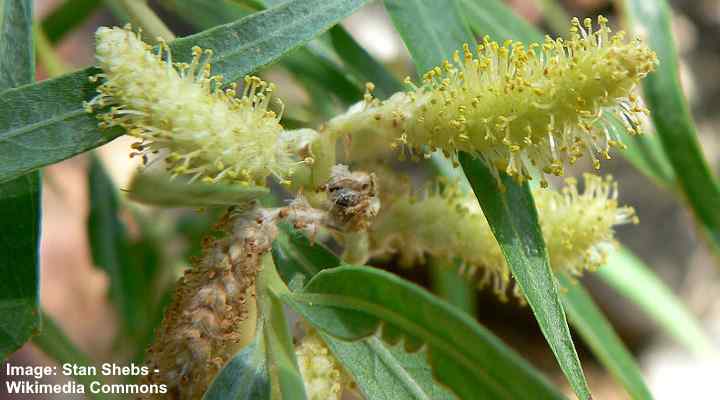
Coyote willow catkins
The coyote willow shrub grows well in USDA zones 4 through 6 in full sun and partial shade. Although it withstands flooding, the landscaping shrub is also relatively tolerant of drought.
Willow shrub identification
The large deciduous coyote willow shrub is identified by its yellowish catkins growing 3” to 4” (8 – 10 cm) long, finely-toothed linear grayish-green leaves and clusters of seed capsules in the fall.
Hooker’s Willow Shrub (Salix hookeriana)
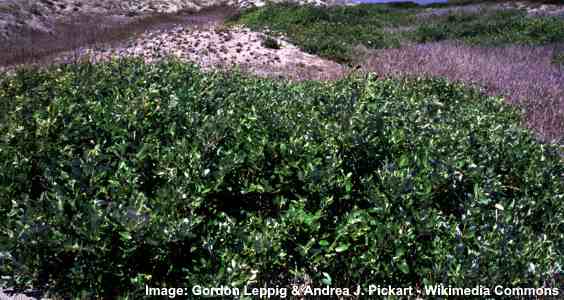
Hooker’s willow shrub grows in coastal areas and has a bushy look
Hooker’s willow shrub is a large shrub or small tree characterized by large glossy green oval to elliptic leaves with wavy edges with a fuzzy underside. The shrub-like silvery-white pussy willow leaves measure 4.3” (11 cm) long, and its yellowish catkins measure 3.5” (9 cm).
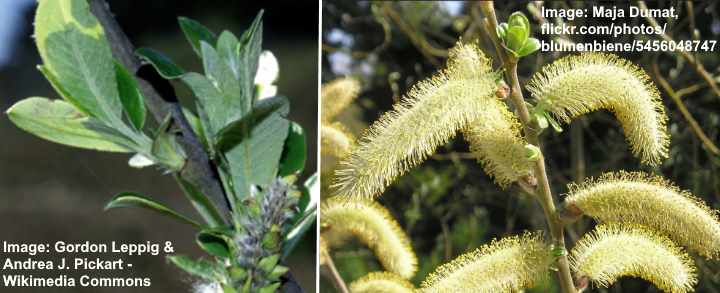
Hooker’s willow leaves and catkins
The Hooker’s willow shrub is native to the western coast of the United States. It grows along beaches, in floodplains, canyons, and marshes. Forming bushy thickets, the large arching shrub is ideal for soil erosion prevention and stabilizing slopes.
Also called the coastal willow or dune willow, you can grow this willow shrub with its dense foliage in your front or backyard. However, to prevent it from growing too large, cut it back in late winter or early spring to 12” (30 cm) above the ground.
Hooker’s willow shrub is suitable for growing in USDA zones 6 to 10.
Willow shrub identification
The identifiable features of Hooker’s willow shrub are its long, pointed ovate leaves with glossy upper side and fuzzy underside and long, drooping yellowish-green catkins.
Related articles:
